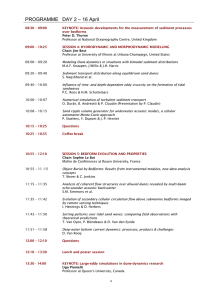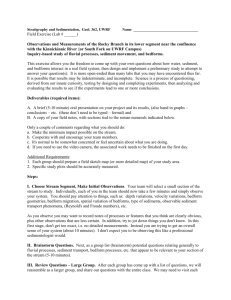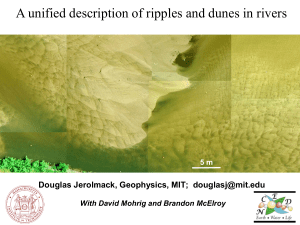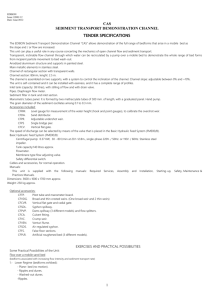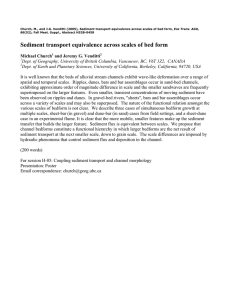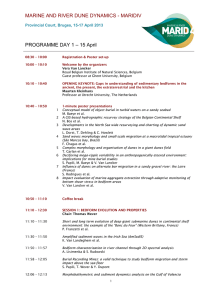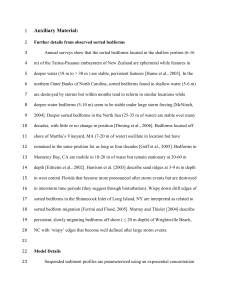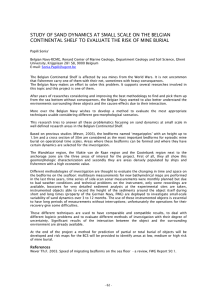Gaps in understanding of sedimentary bedforms
advertisement
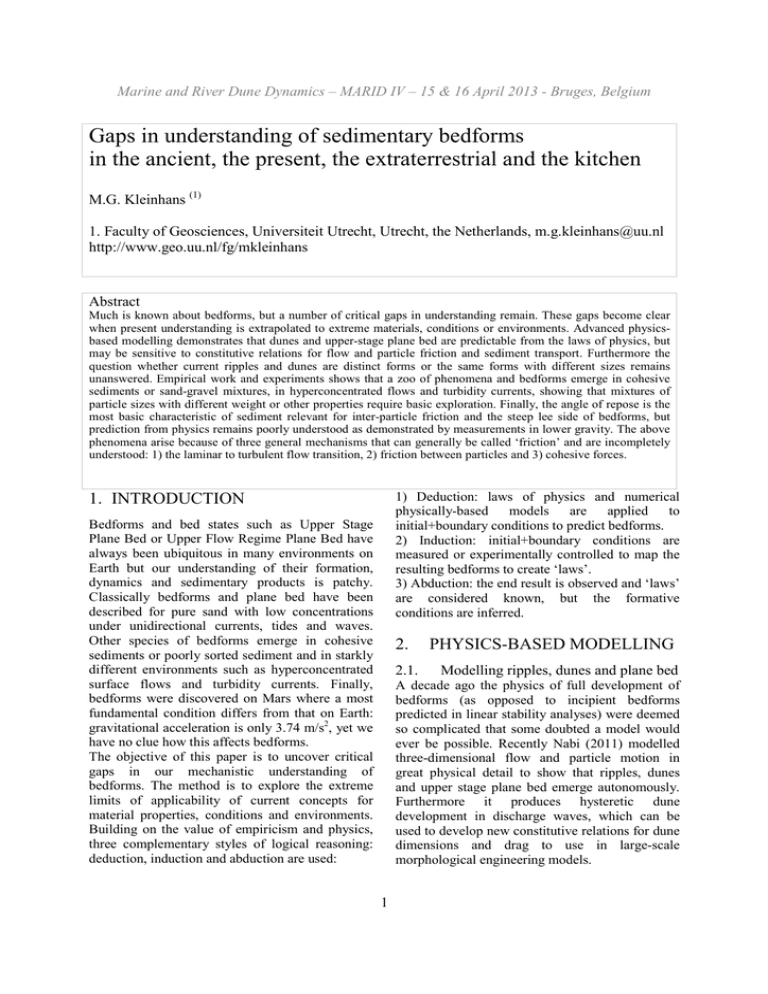
Marine and River Dune Dynamics – MARID IV – 15 & 16 April 2013 - Bruges, Belgium Gaps in understanding of sedimentary bedforms in the ancient, the present, the extraterrestrial and the kitchen M.G. Kleinhans (1) 1. Faculty of Geosciences, Universiteit Utrecht, Utrecht, the Netherlands, m.g.kleinhans@uu.nl http://www.geo.uu.nl/fg/mkleinhans Abstract Much is known about bedforms, but a number of critical gaps in understanding remain. These gaps become clear when present understanding is extrapolated to extreme materials, conditions or environments. Advanced physicsbased modelling demonstrates that dunes and upper-stage plane bed are predictable from the laws of physics, but may be sensitive to constitutive relations for flow and particle friction and sediment transport. Furthermore the question whether current ripples and dunes are distinct forms or the same forms with different sizes remains unanswered. Empirical work and experiments shows that a zoo of phenomena and bedforms emerge in cohesive sediments or sand-gravel mixtures, in hyperconcentrated flows and turbidity currents, showing that mixtures of particle sizes with different weight or other properties require basic exploration. Finally, the angle of repose is the most basic characteristic of sediment relevant for inter-particle friction and the steep lee side of bedforms, but prediction from physics remains poorly understood as demonstrated by measurements in lower gravity. The above phenomena arise because of three general mechanisms that can generally be called ‘friction’ and are incompletely understood: 1) the laminar to turbulent flow transition, 2) friction between particles and 3) cohesive forces. 1) Deduction: laws of physics and numerical physically-based models are applied to initial+boundary conditions to predict bedforms. 2) Induction: initial+boundary conditions are measured or experimentally controlled to map the resulting bedforms to create ‘laws’. 3) Abduction: the end result is observed and ‘laws’ are considered known, but the formative conditions are inferred. 1. INTRODUCTION Bedforms and bed states such as Upper Stage Plane Bed or Upper Flow Regime Plane Bed have always been ubiquitous in many environments on Earth but our understanding of their formation, dynamics and sedimentary products is patchy. Classically bedforms and plane bed have been described for pure sand with low concentrations under unidirectional currents, tides and waves. Other species of bedforms emerge in cohesive sediments or poorly sorted sediment and in starkly different environments such as hyperconcentrated surface flows and turbidity currents. Finally, bedforms were discovered on Mars where a most fundamental condition differs from that on Earth: gravitational acceleration is only 3.74 m/s2, yet we have no clue how this affects bedforms. The objective of this paper is to uncover critical gaps in our mechanistic understanding of bedforms. The method is to explore the extreme limits of applicability of current concepts for material properties, conditions and environments. Building on the value of empiricism and physics, three complementary styles of logical reasoning: deduction, induction and abduction are used: 2. 2.1. PHYSICS-BASED MODELLING Modelling ripples, dunes and plane bed A decade ago the physics of full development of bedforms (as opposed to incipient bedforms predicted in linear stability analyses) were deemed so complicated that some doubted a model would ever be possible. Recently Nabi (2011) modelled three-dimensional flow and particle motion in great physical detail to show that ripples, dunes and upper stage plane bed emerge autonomously. Furthermore it produces hysteretic dune development in discharge waves, which can be used to develop new constitutive relations for dune dimensions and drag to use in large-scale morphological engineering models. 1 Marine and River Dune Dynamics – MARID IV – 15 & 16 April 2013 - Bruges, Belgium The physical nature of the model suggests that these exciting results are universally valid, but the sediment transport description implemented in the model is necessarily semi-empirical. Indeed, alternative constitutive sediment transport relations did not form dunes. This raises the question what the effect would be of alternative physical mechanisms and constitutive relations. Vice versa, alternative choices can provide clues about the best forms that constitutive relations for transport could have, independent of empirical measurement. 1994) show that equilibrium ripples have welldefined dimensions independent of flow velocity, water depth and particle sizes (except close to the boundaries of their stability field), namely 0.02 m high and 0.2 m with a spread of a factor of two. Current work is aimed at understanding the relation between scour holes and ripples and the consequence for the ripple-dune transition. 2.2. Sorting of sand and gravel in dunes In seemingly simple unidirectional flow with sandy gravel several sorting patterns occur, such as fining upward in dunes and transverse sorting in river bends. The sorting has large effects on equilibrium morphology and time scales of adaptation (Blom et al. 2008), which is highly relevant for managed rivers such as the Rhine. Furthermore it interferes with sorting patterns at the scale of bars and bends. But grain-scale sorting on reach-scale river morphology pose a rather large challenge to numerical modelling. Blom et al. (2008) present a sophisticated model that conserves mass of all grain size fractions, models vertical sediment fluxes, and accounts for stochastic temporal variability of dune trough depth. This model constitutes an important improvement over the classic active layer depth where the layer thickness must be calibrated and strongly determines time scales of morphological and or sorting adaptation. The model also points towards the importance of initial sorting conditions and history effects in sorting, which adds a complication to hysteretic bedform dynamics. Figure 1. Bedform height (left) and length (right) development in the Nabi (2011) model under constant conditions starting from flat bed. A long standing dispute is whether dunes and ripples are distinct features or simply different in scale. In bedform stability diagrams ripples occur in hydraulically smooth bed conditions, i.e. when laminar sublayer thickness exceeds particle size. In such conditions local turbulence production over an irregularity or bedform crest locally enhances shear stress. This causes formation of a scour hole which maintains local turbulence strong enough to suppress the laminar sublayer. If this is true then dunes replace ripples only due to an increase of shear stress or grain size and cannot occur in superposition unless in the transition zone. On the other hand, these scour holes are also observed without ripples in near-critical flow, where they add unrealistic effects to scale models for rivers and tidal systems. This suggests that scour holes and rhythmic bedforms are independent forms that are superimposed in the case of ripples, which otherwise are the same phenomenon as dunes. A model such as Nabi’s (2011) can be used to remove or add model components representing physical effects and processes, and can be used to model scenarios. Modelling started from plane bed for a flume-sized domain shows that at small bedforms develop that Nabi calls ripples, which then merge to grow into dunes. Indeed dune height growth temporarily stalls during the transition (Fig. 1). However, the most systematic set of controlled experiments producing ripples (Baas Figure 2. Vertical sorting by dunes (Blom et al. 2008). One important question is what the effect is of constitutive relations for sediment transport. Several mechanisms must be included semiempirically. Sediment pickup and deposition must be corrected for hiding effects occurring with particles of different sizes. Some processes are too poorly understood to be included. Due to hiding, armouring occurs in a mobile layer of a few grains thickness, whereas in partly mobile sediments the 2 Marine and River Dune Dynamics – MARID IV – 15 & 16 April 2013 - Bruges, Belgium tap water as interstitial fluid. Materials with angular grains had time‐averaged angles of about 40° and with rounded grains about 25° for all effective gravitational accelerations, except the finest glass beads in air, which was explained by static electricity. For all materials, the static angle of repose increases about 5° with reduced gravity, whereas the dynamic angle decreases with about 10°. Surprisingly, both depend on gravity and avalanche size increases with reduced gravity. smallest particles contributing to morphological change may be winnowed out of an otherwise nearly static bed by turbulence penetrating the bed, or deposited and percolated into the deeper bed. A second major question is to what extent particlescale phenomena are relevant for reach-scale river morphology. Yet the thin layers used in the discretised numerical model require very small time steps unsuitable for large-scale morphodynamic modelling. Yet dunes modify near-bed flow and thus interfere with transport and sorting processes on transverse bed slopes on bars and in bends. These phenomena call for further study by combination of detailed sorting models, engineering models and dedicated flume experiments to unravel the dynamic interaction between dunes and bars and the transverse slope effect on sediment transport and sorting. 3. 3.1. Figure 3. Typical angles of repose under reduced g. EMPIRICAL EXTREMES Qualitative explanations are that friction is lower in more dilated grain flows in reduced gravity so that the dynamic angle of repose is smaller. The static angle of repose, on the other hand, is related to ‘cohesive’ forces including Vanderwaals and electrostatic forces, which continue to act in vanishing gravity and increase the static angle. We lack the mechanistic understanding to predict angle of repose and friction angle depending on material properties (and gravity). Hence this causes empirical uncertainty in transport predictors. It also raises questions about what happens in bedforms with low density sediments such as shell hash and mud clasts. Furthermore it is the question which angle is likely to be preserved at the planetary surface and in the rock record. Ubiquitous disturbances render the lower dynamic angle of repose dominant in nature. Lower slip face angles reduce flow separation and turbulence generated by flow over bedforms (Nabi 2011). Angle of repose dependence on ‘g’ Noncohesive granular materials are found in many contexts, from kitchen to industry and, notably, the lee side of ripples, dunes and other steep bedforms. A basic property is the angle of repose a: the maximum slope angle at which the material is at rest. Above this slope angle, the material starts to flow. The angle is related to the friction angle of sediment that figures in semi-empirical relations for incipient sediment motion and transport. It is generally believed that this angle is independent of gravitational acceleration g as on other terrestrial planets, moons and asteroids in the Solar system. This belief follows from the Coulomb law and the first law of Amontons. It follows that the driving gravitational force along the slope of a granular flow, Fz = mgeff sina, is balanced by friction, which depends on the force normal to the slope, Ff = mgeff cosa. As both scale with the weight of the flow, the dynamic angle of repose for a granular flow is independent of gravity. Although some observations were done for granular materials under hypergravity, direct measurements of the angle of repose are rare. In 33 parabolic flights in a well‐controlled research aircraft Kleinhans et al. (2011) recorded avalanching granular materials in rotating drums at effective gravitational accelerations of 0.1 and 0.38 times the terrestrial value and at 1.0g as a control experiment. The granular materials varied in particle size and rounding and had Utrecht air or 3.2. Bedforms in sand-mud mixtures Mud occurs in abundance in fluvial and coastal systems since the emergence of plant life on Earth ~400 million years ago. Although mud consists of much finer particles than sand or of low-density flocs with much lower settling velocity, mud and sand often mix. Mud adds a plethora of effects to sediment, including cohesion and reduced pore flow due to blocking. Furthermore mud modifies near-bed turbulence. In novel experiments Baas et 3 Marine and River Dune Dynamics – MARID IV – 15 & 16 April 2013 - Bruges, Belgium al. (2011) found a bewildering variety of bedforms and layer patterns in sand-mud mixtures relevant for tidal environments and turbidity currents. Baas et al. found that bedforms generated in turbulent flow and in turbulence-modulated, cohesive flows differ greatly in their size, texture, sedimentary structure and migration rate as a function of the duration of the formative flow and the texture of the initial flat bed. In particular, the mud, silt and sand fractions mix, segregate or layer rhythmically depending on Reynolds number and near-bed mud concentration. These findings are relevant for mud-silt-sand stratification formed in tidal environments, where critical shear stress for motion will be affected, and for rapidly decelerating turbidity currents in deep water. 4. 4.1. and phases in a turbidity current system and provide detailed information on the formative conditions. This work illustrates that the geologic record may contain a zoo of bedforms that are hitherto unrecognised and poorly understood. 5. CONCLUSIONS The science of bedforms is ultimately founded on classical physics, but three related groups of mechanisms are poorly understood and yet cause a plethora of phenomena highly relevant to the field: 1. laminar-turbulent flow transitions 2. friction between static and mobile particles, particularly of different sizes 3. cohesion: a bulk term for attractive forces between particles of clay-size and larger. The examples further illustrate that complementary approaches in the disciplines studying bedforms reveals where significant progress can be made. BEDFORMS CARVED IN ROCK Hyperconcentrated supercritical flow The classical Bouma sequence of layering in rocks has been used as a conceptual model to infer the formative conditions of turbidity currents. But new systematic experimentation in supercritical hyperconcentrated flow demonstrated that antidunes, breaking antidunes, chutes-and pools and, notably, large, upslope migrating cyclic steps are transitional into each other with increasing Froude numbers (Cartigny et al. in review). In particular such large cyclic steps were hitherto unrecognised bedforms, that now appear to have recognisable stratification in outcrops of turbidity currents. Point characterisation of the flow with migrating bedforms inevitably covers both bedform troughs and crests, and experimentally it was found that a high percentile of the Froude number distribution over time discriminated better than the median between the bedform patterns. Temporally stable bedform types (in dynamic equilibrium) occupy distinct fields in a twodimensional phase diagram with sediment mobility and particle size. However, the fields are modified by sediment concentration and fall-out rate. Cartigny et al. find that various patterns of stratification resembling hummocky crossstratification can be caused by multiple completely different bedforms and conditions. Fortunately, detailed differences exist so that otherwise vague deposits hitherto interpreted as the result of one process can now be ascribed to distinct locations 6. ACKNOWLEDGMENT I am grateful to Astrid Blom, Mohamed Nabi, Jacco Baas and George Postma for discussion. Presented views are entirely my responsibility. 7. REFERENCES Baas, J.H. 1994. A flume study on the development and equilibrium morphology of small-scale bedforms in very fine sand. Sedimentology, 41, 185–209. Baas, J.H., Best, J.L. & Peakall, J. 2011. Depositional processes, bedform development and hybrid bed formation in rapidly decelerated cohesive (mud– sand) sediment flows. Sedimentology 58: 1953-1987 Blom, A., Ribberink, J.S. & Parker, G. 2008. Vertical sorting and the morphodynamics of bed formdominated rivers: A sorting evolution model. J. Geophys. Res., 113: F01019 Cartigny, M.J.B., Ventra, D., Postma G. and Van Den Berg, J.H. submitted. Morphodynamics and sedimentary structures of bedforms under supercritical-flow conditions: new insights from flume experiments. Sedimentology, also open access PhD thesis Utrecht University 2012. Kleinhans, M.G., Markies, H. de Vet, S.J. in ’t Veld, A.C. & Postema, F.N. 2011. Static and dynamic angles of repose in loose granular materials under reduced gravity. J. Geophys. Res. 116: E11004 Nabi, M. 2012. Computational modelling of small-scale river morphodynamics. Open access PhD thesis Delft University of Technology, 224 p. 4
